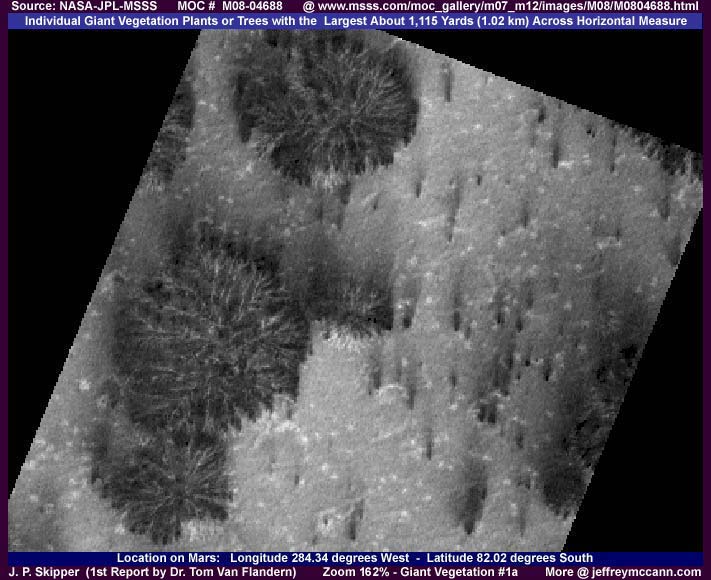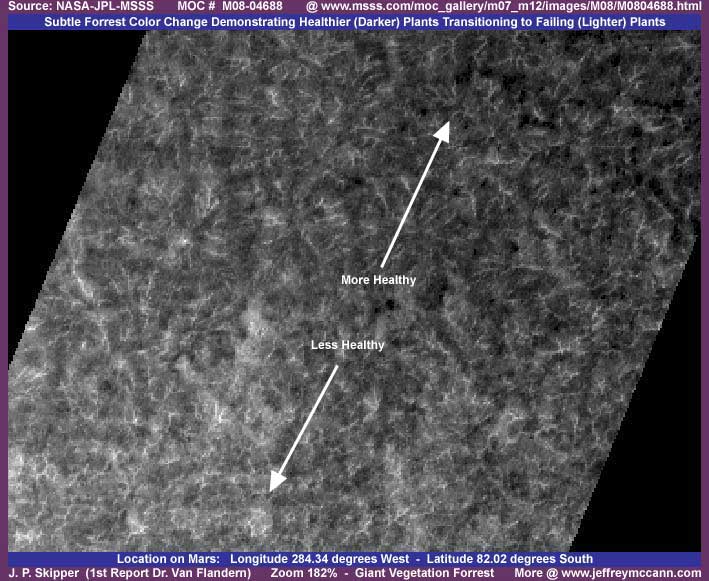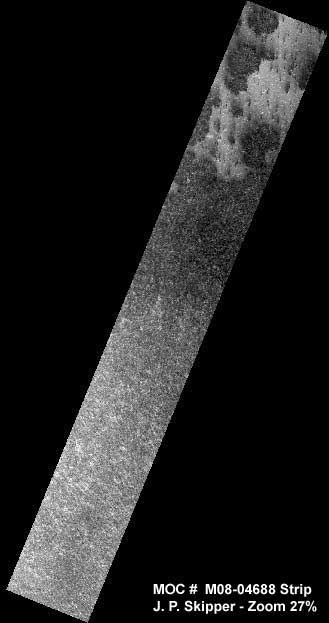
GIANT PLANT SPECIES
FOUND ON MARS
Report #019
May 12, 2001
Can Be Contacted At

Recently Dr. Tom Van Flandern, who's Meta Research web site can be found here at http://www.metaresearch.org/home.asp and who is a principle member of SPSR (Society for Planetary SETI Research), held a press conference at the Press Club in Washington, D.C. where he released a number of his team's discoveries of anomalies on Mars. In the press conference, there was mostly a lot of ambiguous very debatable images and a lot of talk about the frustrations this team of scholars and scientists have with standard peer review publications stone walling publishing their material. There was only a brief passing mention of one anomaly image strip that, in my opinion, is worth more than all the rest of their material combined. The anomalies in that MOC M08-04688 image strip are now presented in my first image at the top of this piece and the second image below.

As you can see in my two images above, this appears very clearly to be plant or tree vegetation of some kind representing the first of this grade of clarity of vegetation on Mars and the first for this particular species of plant life. Actually, I had already discovered this same plant species in another image strip several months ago but the clarity wasn't as good as this, I didn't report on it, and kept waiting hoping to run across just such clearer images as these before posting my own discovery of this species.
Now first discovery credit of this species of vegetation necessarily goes to another but the question is who? I do not believe that this discovery is original with Dr. Van Flandern or his associates. I suspect that this image strip was pointed out to them by another person, a very famous person known to me but who is reluctant to formally connected himself with this work and its controversies and who's name I will not mention here out of respect. Oh well, if true, I'm just glad that this other party did supply the image strip to Dr. Van Flandern and I'm glad that Dr. Van Flandern did present it in his press conference. I just wish the presentation had made more of an issue of it while the opportunity for the media to pick up on it was there.
Just how fantastic is this first discovery? Malin's MSSS web site statistics say that this image strip's scaled width is 2.83 km across. In the first image here, the largest plant second up from the bottom left at its widest point occupies by physical measure 36% of the width of the image strip and that equates to the plant being 1.02 km or 1,019.99 meters across! To convert that to English measure, there are 1,093.6 yards in 1 km. By my simple math calculations, the largest plant in the top first image here is an incredible 1,115.47 yards across horizontal measure. Yes, you read it right, WELL OVER HALF A MILE ACROSS! Now that is an eye opener by any stretch of the imagination! I know I'm impressed.
Can you take in the gargantuan bulk of such a species of vegetation and what it would be like to approach such a monster even seen from a long distance? It would be like looking at a small mountain long before you got to it. One can only imagine how incredibly old and possibly even very ancient this life form is. I chose these first two shots here because some of these plants seem to be growing alone and independent offering a clearer view of an individual plant and the measuring of same. You can perhaps understand that the sheer size of these plants or trees is one of the reasons that I held up reporting on them myself as I assumed that the average viewer, especially with my own less clear and less obvious images, would find plant life of this bulk and magnitude a little too incredulous to grasp if there was any ambiguity at all to the image.
In this second image taken of the terrain just below the locale of the first image here, you see more individual plants in the upper half of the shot and then in the lower half you see the beginnings of a dense carpeted mass of these plants that extends in a thick jumble much further down in the image strip. In fact, it looks to be an impenetrable forest of these plants or trees. However, one of the first things that struck me as odd about this scene though was the lack of a pronounced shadow thrown on the ground by any of the plants. Now a plant or tree half a mile across is gigantic pure and simple by any standards. Even if it lies low on the ground with the ground supporting most of its bulk (likely), the sheer mass of it would still give it a lot of height and some significant shadow should be expected to be there but it is not. This has caused me to look extra close at the plants/trees AND the apparent open terrain around some of them.
After this close examination, the results are not definitive but I can say that the vegetation continues to look just like real plants or trees seen from the top with the obvious radial limbs or branches with foliage radiating out from a central core just like plants or trees we are used to seeing on Earth except for the size factor. But, on the other hand, it is the open terrain that looks questionable to me. In my first image here, the open terrain area looks fairly real. But, the apparent open terrain in the second image above most definitely looks to me to be highly suspect and not simple ground terrain at all. That causes me to suspect the open terrain in the first image as well. I can not say whether this is image tampering in the second image or something higher off of the true ground between and amongst the plants. In the second image, here again no shadow is cast because either a image tampering application has overlaid over the nearby ground creating the open terrain look and hidden the shadows or something else actually on Mars that I can not identify is rising up from ground level to tree top level preventing view of the true ground below and any shadow thrown on it.

The third image above is taken a little further down in the strip and demonstrates two things. First, you can see how thick and dense this tightly packed forest of plants/trees is or perhaps I should say was. Second, it shows more healthy but still failing plants in the upper portion and outright field of dead plants in advanced deterioration in the lower portion and this gets worse the further down in the strip you go from this point on. Pay attention to this type of terrain in the lower portion because you will see it again in other image strips that I will later report on where different species of plants are taking root in this heavy decomposition vegetation matter.

Above is the fourth and final image in this report representing the entire image strip on a small scale necessary to fit into this report. The reason that I have included it here, other than as a location reference for my first and second images above, is to demonstrate how thick and extensive the forest is and the all important color gradations in same. The darker areas represent fresher healthier vegetation and the lighter the color grading the more and more unhealthy and dying or dead the vegetation. The point is that this demonstrates that this image strip's length covers different stages of health of this vegetation which demonstrates that this is a true living dynamic vegetation ecology.
When you understand how thick and massive each individual plant is, you can imagine that a dead plant creates a large hill of decomposing matter and many of them tightly jammed together in the thick forest setting create a very jumbled terrain where the ground is covered by hill after hill after hill of these massive rotting giants and the true ground is not visible at all beneath this mass. In my other discovery image strips that I've had for some time now, I have this same terrain consisting of these same rotting giants and other different types of plants are taking root and growing in their rotting bulk creating new and different types of forest where individual plants space even measured distances from each other giving a very uniform appearance. Truly, Mars is a fantastic place and stranger than fiction in so many ways.
Another point should be made here. Dead individual plants of this species appear to look just like the healthy plants except going pale and the individual branches outlines just growing more indistinct consistent with in place deterioration. If these were tall trees with long trunks as we are used to seeing on Earth, then one could normally expect that at least a few would fall over on their side when weakening and dying exposing the trunks to view. Since I do not see any evidence of this process taking place with the dying and dead of this species, I am inclined to assume that these are more akin to gigantic plants or bushes growing radially from a central core prying out room for themselves in thick same species forest settings. That would mean that most of the bulk of the radial branches near the bottom are supported by the ground and higher branches are supported by lower branches below. Alternately, they may be shorter trunk trees simply held in place upright by being so tightly packed against each other resulting in them deteriorating in place. Also, perhaps these giants trunk system is there but its length may be expended below ground drilling deep into the planet like a great tape root for water and nutrients? Either way, this would mean that this is a lower growing species not given to tremendous heights off the ground except that dictated by sheer massive bulk.
You should also be aware that the terrain of this M08-04688 image strip is located at the South Pole of Mars which it and the North Pole are the most heavily imaged areas on Mars. There is substantial vegetation in a encircling band around the South Pole between 75 degrees and 85 degrees south. Too far in toward the pole center is ice and too far out is more desert conditions.
RECOGNITION & CREDIT DUE
My personal thanks goes out again to who ever first discovered this image strip offering such a excellent view of this giant vegetation and thanks to Dr. Van Flandern for first initiating bringing this to the public's attention at his recent press conference. Now that such a image strip of obvious vegetation has been presented and some may now eventually come to accept that vegetation on Mars is possible, I can now start releasing the various vegetation species discoveries I have (including the giants seen here) that I have been holding back because I thought the public would regard them as too incredulous. Thank you who ever you are for opening the way on this particular subject matter.
DOCUMENTATION
All my images here in this report have been sourced from the NASA/JPL/MSSS official MGS MOC M08-04688 original image strip. You can access it here at http://www.msss.com/moc_gallery/m07_m12/images/M08/M0804688.html. I took my images from the second listed best quality slower loading sinusoidal projection gif image strip but all the image strip options there work fine and have the correct orientation. The quicker loading 1st listed medium quality jpeg strip will do just as well and enables a quicker larger view of the whole strip and therefore a better view of the changes in the health of the vegetation.. I have not attempted to access this material elsewhere, such as PDS/USGS, and can not comment on it there. Good Luck.
, Investigator
![]()